(February-March 1943, 75m) Director: Malcolm St. Clair Released: Twentieth Century-Fox, June 25, 1943 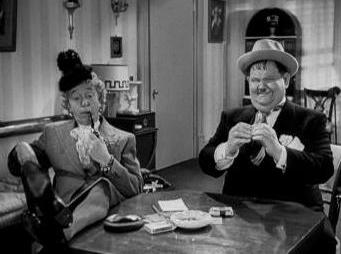 Twentieth Century-Fox had developed more scripts for Stan and Ollie to return to, many of which - thankfully rejected - featured more Nazis. The script eventually used was written by staff writer Scott Darling and directed by Malcolm St Clair, a man who had worked with Buster Keaton. Both men were more amenable to input from Stan, and a more relaxed working atmosphere was borne. The end result is by far the best of the post-Roach movies. What helps is that not only are Stan and Ollie shockingly as near to being in character as they'll ever be but they even get to do some alternate characters in disguise, with Hardy as a southern gentleman and Laurel back in drag again. Stan even gets a classic Stanism: 'You know, Ollie, I was just thinkin' 'What about?' 'Nuthin', I was just thinkin'. Okay, there's still a little of that subservience in the boys so that their dreams are based around spending their lives working for a young couple and the plot can be convoluted like all the Fox plots, but these work better than elsewhere. The tagline to the film could almost be 'you can con a conman' as Robert Bailey's confidence trickster crusades against a larger mob. What stops the Bailey-Vivian Blaine subplot from getting mawkish and tedious are the shades of grey in Bailey's character combined with Blaine's onscreen presence. Bailey's 'Chester Wright' is a man that lives by conning people out of money, but this isn't picked up on by Stan or Ollie. That he operates by a code of questionable ethics gives his character a hint of questionable danger and makes the audience uncertain of whether or not they should be on his side. Blaine, for her part, gets some nice song routines. It's possible that the film is flattered from that which surrounds it, and certainly if this had been sandwiched in between the likes of Way Out West and Block-Heads then quality downturn would be more marked. But coming as it does after the likes of A-Haunting We Will Go and Air Raid Wardens it's a massive leap upwards towards mediocrity. Finally, we may not get the KuKu theme in the Fox films, and we don't get 'why don't you do something to help me?' but we do get the cross-over of that familiar second catchphrase. After a misfiring trial run with 'here's another nice predicament you've gotten us into!' in A-Haunting We Will Go here we get two utterances of that much-misquoted 'nice mess'.    (May-June 1943, 63m) Director: Malcolm St. Clair Released: Twentieth Century-Fox, November 19, 1943 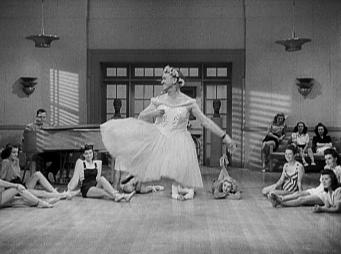 As if realising that they'd let people down by making a decent movie last time out with Jitterbugs, Twentieth Century-Fox return to form by producing an hour's worth of insufferable garbage. In the Hal Roach era then violence between Stan and Ollie was never troubling because not only did both operate as human cartoons but the size difference between the two was never as pronounced. Stan looked a fairly sprightly young man, not the aged 53-year-old that he is here, and Hardy was the put-upon heavy, not a man twice Stan's size. Better still, the violence between them was closely governed by karmic laws, whereby virtually any pain Hardy attempted to inflict upon Laurel would instantly backfire, causing more distress to himself than his would-be victim. Plus, you knew that within seconds the two would be pals again and it'd all be forgotten. Not so here. There's no love between Stan and Ollie in this film, only the assumption of friendship borne out of knowledge of their prior exploits. Hardy, in a reprise of The Battle of Century, attempts to injure Stan in order to get some money on an insurance policy. In fairness, this particular sequence does see Ollie come worse off, but throughout the film prior to this Stan gets pushed around, has a balloon burst in his face, and is generally mistreated. When he speaks up for himself he is reminded by Hardy that there's nothing he can do to prevent being physically abused. Take away the element of Stan hurting Ollie in return, take away Ollie's abuse backfiring and take away the element of friendship and you're left with one thing... a spiteful bully. Oliver Hardy as a spiteful bully is not a pleasant viewing experience. Like watching an old friend turn bad, this severely misconceived characterisation is bolstered by the return of Robert Bailey from Jitterbugs and the hiring of Margaret Dumont, that great foil of The Marx Brothers. Sadly, Bailey shows that he can be as boring as the next guy when given that much-celebrated role of 'sappy romantic lead' and Dumont is completely wasted. Despite this, Hardy idolises Bailey's character and even offers to clean his trousers for him(!), leading to a chain of events (don't ask) that sees Hardy stuck on a runaway double decker bus in scenes that make the end of County Hospital look like state of the art CGI. Stan ends the film getting balls smashed into his face - good joke, eh? - and Hardy spends the climax on a pathetic toy bus on a rollercoaster model. It's turgid, depressing stuff, it really is. Perhaps the sole worthwhile element is Stan's 'Dance of the Pelican', which, while not really dignified, does show an amazing grace for a man of his age. Yet for the rest of the film his performance is sponsored by Alexander Graham Bell - the poor bugger's phoning it in. You know what? I don't blame him in the slightest.   (July-October 1943, 79m) Director: Sam Taylor Released: MGM, December 6, 1944 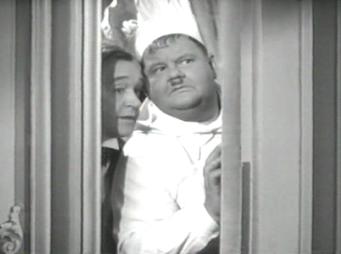 After completing The Dancing Masters Stan and Ollie returned to MGM for another one shot deal with Sam Taylor, the talented director behind Harold Lloyd classics Safety Last! and The Freshman. Writing started with a large team, including Buster Keaton (none of whose input survived in the movie) from July 1943. After a long gestation period the film was shot in October 1943 and then held back for over a year before release. I don't actually hate Nothing But Trouble, though I feel I should. Most of the Fox movies are desperately unfunny, yet Nothing But Trouble manages to avoid the 'unfunny' tag. The reason for this is quite simple... in order for a joke not to be amusing, there must be a joke in the first place. Nothing But Trouble has none. It's like watching some kind of kitchen sink drama as Stan and Ollie spend all their time looking after a small boy who happens to be the king of a made-up country. The kid seems as if he's dubbed, and Stan and Ollie are in full 'we're not worth a damn' mode, with Stan saying the totally unbelievable line of 'we're just nobody'. Stan's lack of interest in proceedings is palpable. Though he tries to justify them hanging around with a small boy with a career-worst line of 'we think kids are nice', a later scene where Stan and Ollie are released from prison sees him momentarily forget the boy's name, telling you all you need to know. Laurel's so bored that even his hair isn't standing up, and the self-pitying, sappy and verbose 'Stan' he plays in this film is arguably the most out of character he ever was. The general scenario also fails to ring true - maybe Stan and Ollie have fatherly feelings towards the boy king, but as the real-life Stan and Ollie seem to care as much about the boy as the audience do - ie. not at all - then it never feels real. Some of the few 'comedy' moments include Hardy pushing some boys over on a field, using a saw to cut a steak and pretending to be a female lion. It's as if MGM were annoyed that Fox had produced the worst movies and were trying to one-up them. On the strength of this they almost succeed, though lucky for Fox they had yet more garbage up their sleeve...   (December 1943-April 1944, 74m) Director: Mal St. Clair Released: Twentieth Century-Fox, September 22, 1944 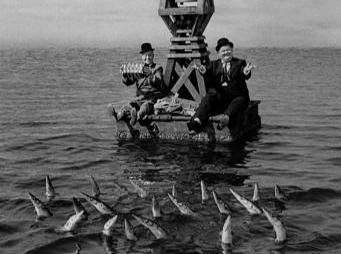 On March 6th 1944 Stan and Ollie recorded a never-aired pilot for a possible radio series where each week they'd get a new job. The pilot, 'Mr. Slater's Poultry Market', ran for just under 26 minutes and was forgotten for many years. As part of the content involves the two stars talking about beheading chickens (the joke being that the person they're telling mistakenly believes they're hit men gangsters) then it's perhaps lacking in the warmth that classic era Laurel and Hardy gave us. This is also Stan and Ollie very much in their Fox personas, with Stan at one point suggesting that a man insulting them could call them 'morons'. Despite the ill-fitting script, and the fact that the National Broadcasting Company never took the series up, the enthusiasm of the two stars and the audience listening to the recording is vaguely infectious. It's also one more chance to hear Stan and Ollie sing as they give - in a presage of their next film - a rendition of 'Mairzy Doats', and there are at least a couple of occasions where you can hear Ollie laughing as Stan fluffs a line then milks the mistake to amuse the audience. It's pretty charming, in its own way, and is worth seeking out. The same can't really be said of The Big Noise, a film once notorious for featuring in the 1978 book 'The Fifty Worst Films Of All Time', as well as many poor reviews upon its release. It's perhaps a little unkind, if only a little. In fact, not only are there fifty worse films than this, but it's not even, sadly, the worst Laurel and Hardy. I've fluctuated on it in the past, giving it two bowler hat stars on initial viewing, then taking it down to one for the second time round. But here it's back up to two, if only for the improvements it makes when watched in context. The Big Noise features more rip offs of previous Laurel and Hardy movies than any other 1940s film (when they're as blatant and as illogical to the plot as this they can hardly be termed 'homages') and doesn't even really feature Stan and Ollie as the main characters. Instead, it's the story of ker-azee inventor Arthur Space and his wacky inventions, with Stan and Ollie as two detectives there to look after him in an exposition-crammed plot. Like A-Haunting We Will Go a sizeable percentage of the runtime (over 15 minutes) doesn't even feature the two stars, almost to spite anyone who was na�ve enough to expect to see Laurel and Hardy in a Laurel and Hardy movie. Yet despite this, it's another instance of Stan and Ollie acting almost like Stan and Ollie. Not a funny version of Stan and Ollie, true, but a version nonetheless. The fact that most of the 1940s movies get bonus points for featuring the lead characters behaving as themselves speaks volumes, but here we get the return of Hardy's fastidious body language and even the resurrection of 'do something to help me!', last heard in The Bohemian Girl. Bobby Blake, although only ten years old when this film was made, already had fifty-five film appearances to his name, or, to be more accurate, many of them to the name 'Mickey Gubitosi' with the 'Our Gang' series of films. While his part in the film as the inventor's son is largely superfluous and he doesn't have any real interaction with the two stars, Blake achieved notoriety in 2005 by going on trial for the murder of his wife. He was found not guilty of murder on March 16th, 2005, though confusingly, Blake's four children filed a civil suit claiming that he was responsible for their mother's death, with a jury finding Blake liable for the wrongful death of his wife on 18th November 2005. Such legally perplexing issues saw him ordered to pay $30 million, and Blake filed for bankruptcy on February 3, 2006. One of the better scenes has a recreation of Berth Marks, but with a drunk character getting involved in the mix. If this was still the Roach years and the drunk was played by Arthur Housman then maybe it would be worthwhile, a sign that the crew were at least trying, despite stories that they ignored Stan's suggestions for improvements to the scene. Of the said scene then it's rumoured that if you turn the volume up loud enough and listen closely you can hear the crew laughing during this sequence... a sure sign that they were handing out free crack when the film was being made. No, The Big Noise is never funny and it is a very poor film, but somehow steers clear of the bottom of the barrel. The most troubling scene is saved until the end - apolitical innocents Stan and Ollie see a Japanese submarine and throw a bomb on it, killing all on board. Four years earlier Chaplin had starred in The Great Dictator, a film asking for peace. Yet here was his old room mate, stuck in a heavily below par movie crassly bombing the enemy. Stan was lucky they got out of the Fox contract when they did... if he'd been working for them much longer they'd have probably had him flying Enola Gay.   (Mid-1944-December 1944, 61m) Director: Mal St. Clair Released: Twentieth Century-Fox, May 11, 1945 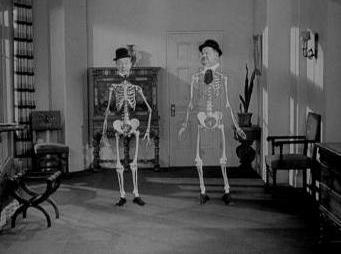 Filming for The Bullfighters took place in November/December, the 'mid 1944' of the credit accounting for the writing, which took place on unrecorded dates in the middle of the year. The fourth and final entry in Stan and Ollie's association with the Darling-St. Clair pairing, after which they declined to make any more. With Fox's B-Movie product being phased out they decided to retire, with Stan telling Arthur Friedman in 1957 of the Fox product: 'it was a disgusting affair to us all the way through, so we were happy when the contract was called off.' Again, though, it's all about context. Watch The Bullfighters in isolation and what you'll see is a very poor film, one that I've given a single star to on occasion. But watch it in the run of dirge-like movies from A-Haunting We Will Go to The Big Noise (Jitterbugs excepted) and it's, in principle, something of a step up. That 'principle' is allowing Stan to get involved, if only a little. What input he had in the creativity of these films is a fraction of that for the Roach movies, but here Stan gets to direct two scenes, the fairly amusing water fountain sequence, and, reputedly, the Hollywood Party reprise of the egg breaking scene (ruined by silly chicken noises over the soundtrack). Not only that, but we get the last of Stan's 'body horror' pay offs, whereby Stan and Ollie end the film skinned alive. But good intentions do not a good film make, and Stan and Ollie of the 1940s are the same as they always were: Ollie almost completely unrecognisable and seemingly incapable of attracting audience sympathy any longer, with Stan looking old, tired and bored. It's a saddening admission as I grew up loving Laurel and Hardy, but the Laurel and Hardy from 1941 onwards just aren't very funny. Stan's no longer a semi-genius producing work that has some layer of depth as well as humour... he's just an indignant actor reading scripted lines from writers that don't understand him. The plot sees the duo as two quite useless detectives who get mixed up in a bullfight due to Stan's uncanny likeness to the Barcelona bullfighter Don Sebastian. (Simon Louvish's fine book 'The Roots of Comedy' points out that the comedy The Kid From Spain had had someone impersonating a Don Sebastian II 12 years earlier). An example of how botched the humour can become is when the real Sebastian successfully fights a bull - a drunken Stan is hurled into the arena by Ollie. The bull looks on, confused, and, after having fought Sebastian (who Ollie thought was Stan) gets ready to resume the conflict. So you have over two minutes of Stan-as-Don fighting a bull, often made up of stock footage (are you following this?) and, after having sat through all that, you then have the pay-off of a drunk Stan getting hurled around by a bull - yet the crowd storms the arena and it never happens. So what's the point? It's like a comic set-up with the joke taken out, and fails to satisfy. The only remaining 'gag' in the piece is that Ollie watches Sebastian and marvels at how good at bullfighting he is, because he thinks it's Stan. It's a punchline-free set-up, which pretty much sums up the entire affair. The final shot of the film was introduced to new audiences when it featured in The X-Files episode 'Clyde Bruckman's Final Repose'. Bruckman was, of course, a movie director from back in the silent era who had co-written and co-directed Buster Keaton classics including The General before committing suicide in 1955. His Laurel and Hardy directing credits included Call of the Cuckoo, Putting Pants On Philip, The Battle of the Century, Leave 'Em Laughing and The Finishing Touch. Bruckman had also directed Laurel in the 1925 short Cowboys Cry For It and Hardy in 1927's Love 'Em and Feed 'Em.  
| ||||||||||||||||||||||||||||||||||||||||||||||||||||||||||||||||||||||||